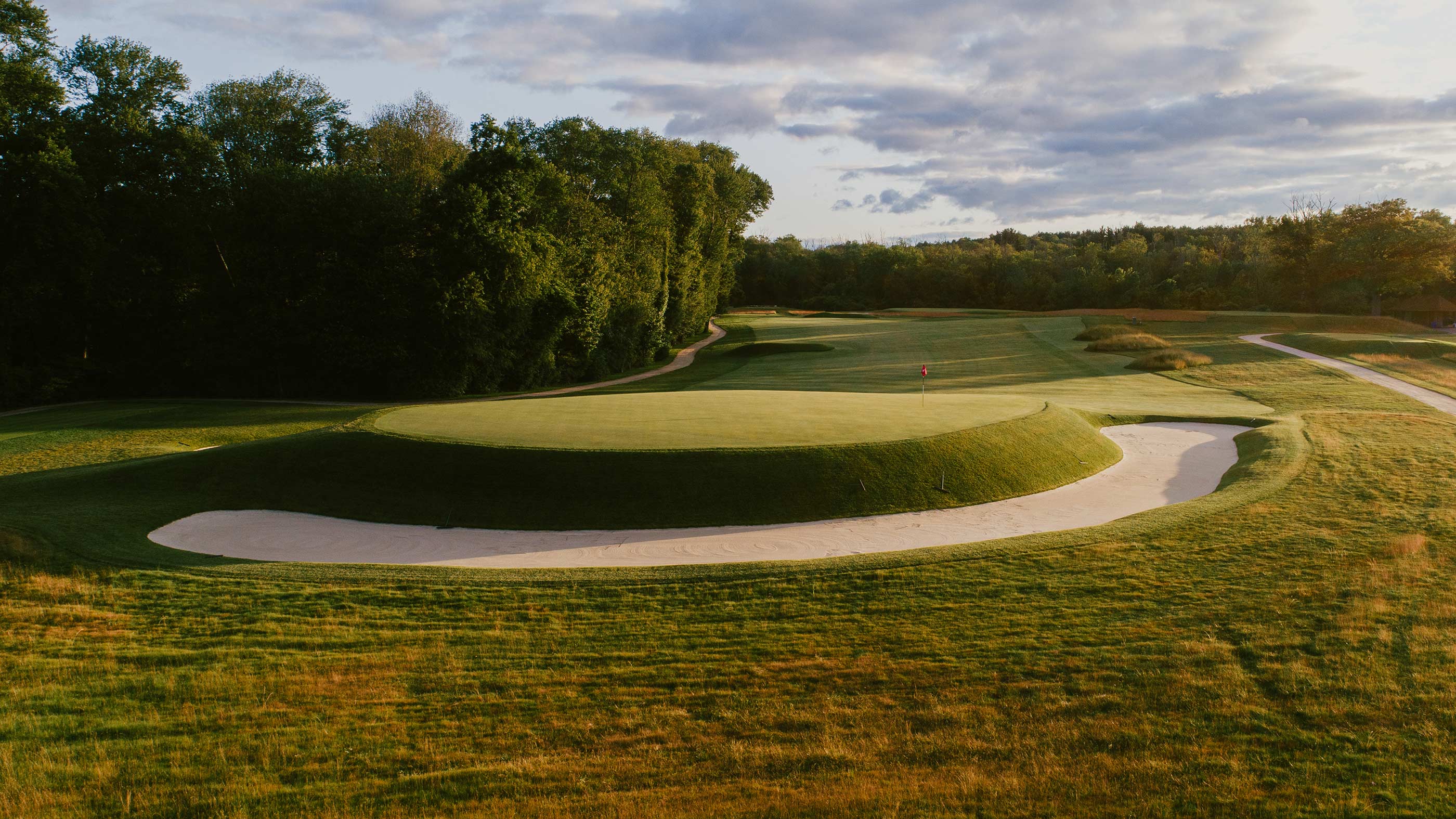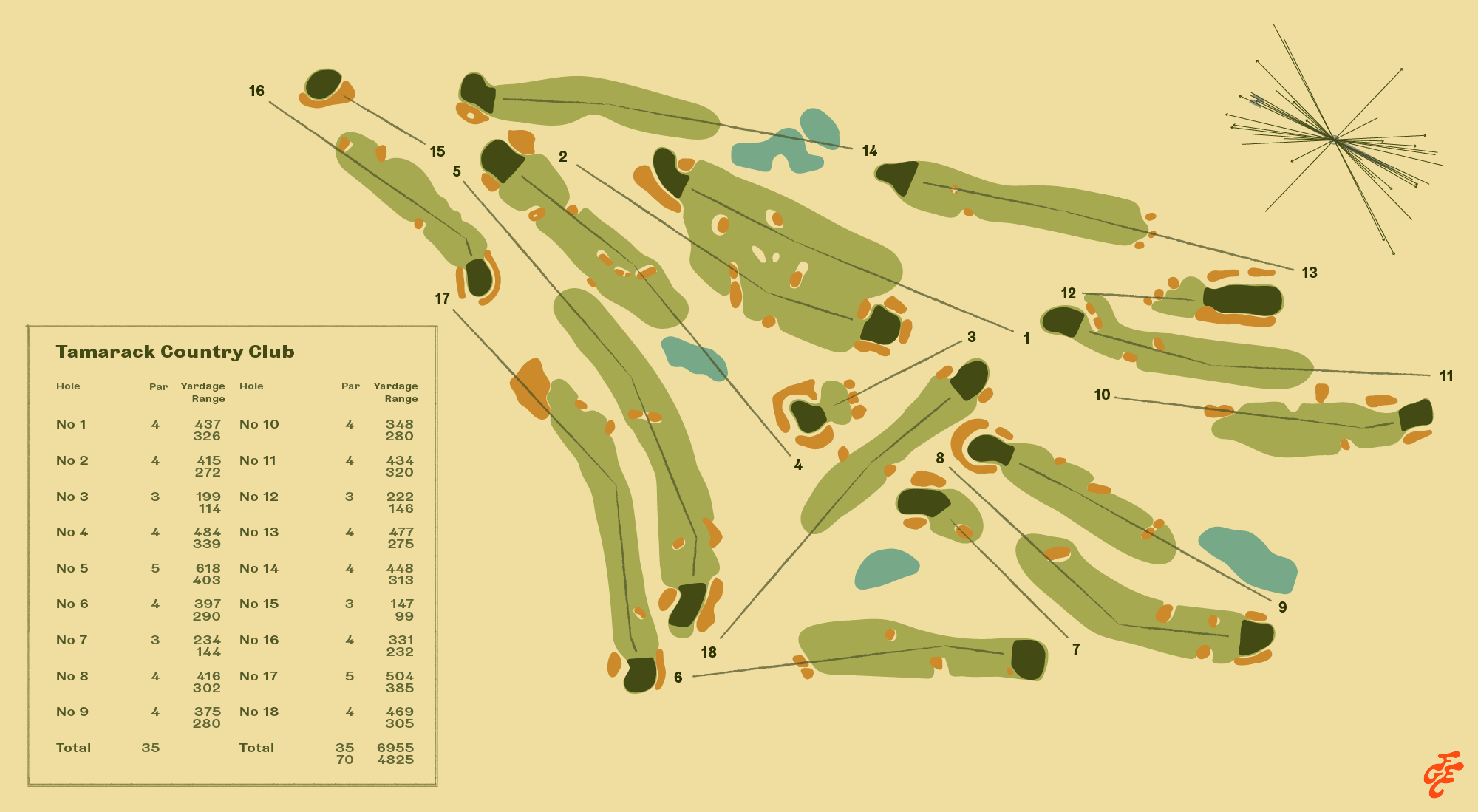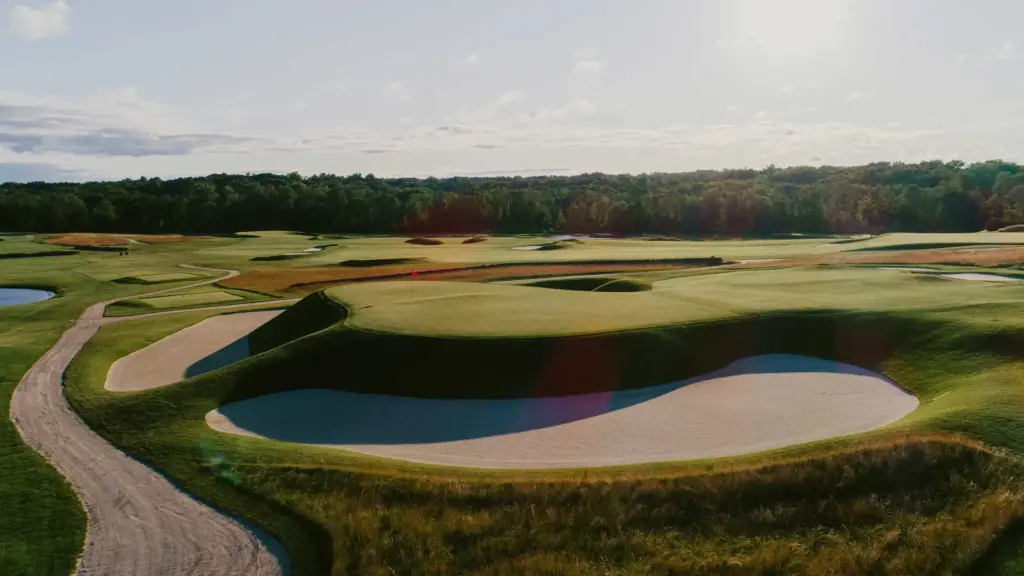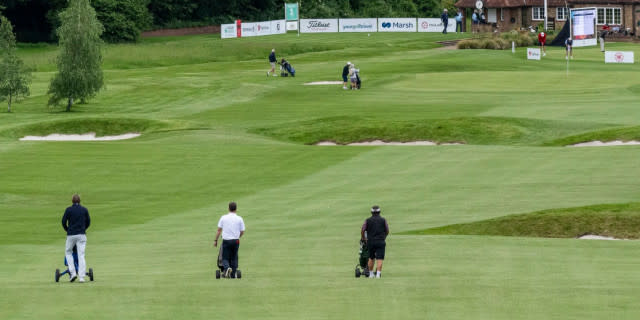Favorite Hole
No. 4 (Bottle), par 4, 339-484 yards
The fourth hole is an encapsulation of the modern Tamarack’s mixture of Golden Age and modern architecture. This long par 4 began its life as a Bottle template hole but evolved away from those design elements over time. Schneider decided to bring the Bottle character back.
As indicated by its name, the hole pinches in the landing area. A line of center-line bunkers is in play for all players. Off the tee, everyone has the option to lay up short of all the bunkers, play up the wider left side, or try to fly the bunkers up the right side of the hole. The farther you try to hit the ball—up both the left and right sides—the narrower your landing zone gets. The approach encourages a low, running shot as the green is perched up ever so slightly. This is a welcome sight for many players, as those who miss the fairway or lay back will have a long shot for their second.
While the fourth green is the flattest on the course, Schneider infused interest in the putting surface by adding two raised sections to the middle that cause issues for anyone who finds themselves with the mounds between them and the hole. These features are very subtle, like two rumples in a bedsheet that wasn’t tucked in properly.
{{tamarack-favorite-hole-gallery}}
Overall Thoughts
Charles Banks has never been accused of holding back. Like his Midwest counterparts Langford & Moreau, Banks used steam shovels and heavy machinery to create dramatic slopes. At Tamarack, those slopes are not only present but present at an extremely large scale. The restoration work only serves to accentuate these design elements, once again allowing the world to see the best of Charles Banks.
The course’s architectural intent can be seen before a single shot is even hit. Just off the clubhouse patio and squarely in your face as you exit the locker rooms is a restored bunker that rests behind the ninth green, 15 feet below the putting surface. The bunker isn’t visible when you play No. 9 but everyone knows it’s there, an example of the mental mind games Banks implemented throughout the routing. No. 3, an Eden hole, might be the most eye-popping example. This 200-yard par 3 is surrounded by bunkers between eight and 10 feet below the green. And even though the green is enormous and leaves plenty of space to land the ball, one can’t help but think of the sandy graves that surround it.
On the first tee, a first-time visitor might be unimpressed by Tamarack’s property. I’ll admit I was. The elevation drop off the first tee is significant, but it appears that the land out in front of you is rather flat. Very quickly you learn that this is not the case. While Nos. 1 (“Road”), 2 (“Cape”), and 4 (“Bottle”) occupy the least interesting terrain on the property, they use strategic elements and extremely bold features to keep your mind occupied despite the lack of topographical interest. Schneider infused aesthetic appeal to this opening stretch through mounding in the expansive double fairway and impactful bunkering in the landing zones and around the greens. The golfer is taken through the most uninteresting portion of the land with demanding approach shots on each of the first four holes.
{{tamarack-opening-holes-gallery}}
After tackling the flat land in the middle of the property, the front nine at Tamarack ventures southwest and shows the player just how good the land is. The long par-5 fifth dips through a valley before rising back up in a long approach to the green. No. 6 continues to climb, this time along the property line, deceiving the player with a raised berm short of the deceptively large green, and ultimately leading to the reveal of the Redan seventh, a long and audacious par 3 with an incredible putting surface. Look in the Tamarack yardage book and you’ll find “No!” written in the back-right bunker on No. 7. From personal experience, I would advise you to follow that instruction. A revived par-4 8th brings you to the southwest corner of the property and one of the most difficult greens on the course.
Perhaps the only lackluster shots at Tamarack come on Nos. 9 and 10, two holes that play on either side of the drive into the course. Both greens feature deep green-side bunkers that add a fear factor to the approach, but with modern technology neither hole really presents much of a challenge to the skilled player. Like the less-than-stellar land on the opening stretch, Banks used intense shaping techniques to infuse interest on these holes. The penal design doesn’t quite do it for me on these two approach shots, although I’m sure anyone who has been stuck in the greenside bunkers would disagree.
The back nine increases the tempo in short order. The Punchbowl 11th provides a chance to score before an incredible Biarritz No. 12 and beefy Double Plateau No. 13 demand great shots for a look at birdie. More than 70 yards long, Biarritz green tilts ever so slightly with the terrain and feeds balls to the left. The back section of the green also features a subtle thumbprint, adding further intrigue. At the northernmost corner of the course, you’ll find a tremendous Short No. 15 along with a hole Brian Schneider altered substantially, the short par-4 16th. To match the architecture found elsewhere on property, Schneider raised the 16th green more than four feet and added native grasses to the mounding left of the landing area. In the right wind and with firm conditions, long hitters could try to overpower this hole, but if they find themselves on either side of the green, they will be in a world of hurt.
 The 16th green at Tamarack Country Club (Fried Egg Golf)
The 16th green at Tamarack Country Club (Fried Egg Golf)
The final two holes close with design elements we’ve seen throughout Tamarack’s routing: bold shaping and demanding shots. Both Nos. 17 and 18 play uphill in their approaches with false fronts short of the greens. The bunker short and right of the 17th may just be the deepest I’ve ever seen. And the trek uphill to the 18th is the architect’s final challenge.
Charles Banks had an extensive design career working alongside the legendary Seth Raynor, making a name for himself along the way. After seeing the restored Tamarack, I have to believe this is his crowning achievement as a solo architect. Not only are his template holes at least as bold as those found on a Raynor or C.B. Macdonald design, but his original holes are incredibly imaginative. I won’t say that all of Tamarack’s greens are the most intricate you’ll ever play, but the more simplistic designs have bold shaping and extreme bunkers to infuse interest. Schneider and Renaissance Golf also elevated elements of the course through modifications that blend in wonderfully with the original work. Modern-day Tamarack puts Charles Banks’s talents in the bright lights he deserves.
2 Eggs
(How we rate courses)
If Tamarack were located 12 miles south in Westchester County, I firmly believe it would be talked about as one of the best courses in the area. Its architecture is unabashedly in-your-face and its property provides a canvas that doesn’t overshadow the design but works with it to create terrific golf holes. The course’s presentation captures the demanding spirit of Banks’s work, although I do worry that there may be times where green speeds could limit the effectiveness of the architecture. Overall, Charles Banks would be proud of how Tamarack plays nearly 100 years on.
Course Tour Illustration by Matt Rouches
Illustration by Matt Rouches
{{tamarack-course-tour-gallery-01}}







